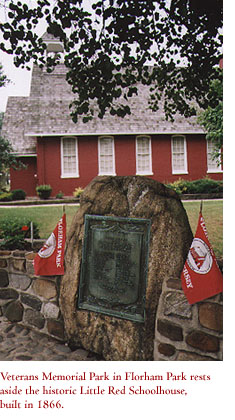

|

Florham Park Against a backdrop fit for a Norman Rockwell painting, Florham Park reflects its past while working hard toward its future. Actually, working hard has long been a character trait of this community. During the early 1800s, ice houses in the borough supplied a widespread area with heavy ice cakes, dragged by horses from the winter ponds and insulated in layers of thick sawdust until mid-summer. A thriving cider and vinegar mill was maintained for 150 years until the 1970s’ apple blight. Florham Park also took on an overflow of rose-farming from nearby Madison, erecting greenhouses as early as 1888 and raising roses under 55,000 square feet of glass. Furthermore, a string of broom factories became important enough to nickname the town “Broomtown.” Athough of working-class roots, the town is well known and indeed is named for the elite who settled there. Members of the upper class flocked to the picturesque community and, in 1898, the Twomblys and the Vanderbilts rode into town on shiny carriages with high-stepping matched teams and top-hatted drivers and footmen in full livery. Quickly earning the affection of the locals, the aristocracy became part of the fabric of Florham Park, and the borough eventually adopted the name that Florence Vanderbilt and Hamilton Twombly gave to their summer estate (Florham, a combination of portions of their first names), which spanned close to 200 acres almost entirely in Florham Park. Not only the millionaires saw the beauty in the landscape that stretched around them. The possibility of athletics fields and dormitories attracted schools and colleges. Seton Hall University was founded in Florham Park in 1855, and its central building was a former dancing academy for girls. In 1860, however, Seton Hall relocated to South Orange. |
|
|
. |
In 1899, led by Mother Mary Xavier, the Sisters of Charity established the College of St. Elizabeth, the first New Jersey college to grant degrees of higher education to women. In 1901, the college’s first building, Xavier Hall, was constructed, and it now serves as the main building for the Academy of St. Elizabeth. Florham Park solidified its reputation as a college town when Fairleigh Dickinson University purchased the splendid Twombly estate and opened a campus in 1958. In the Images of America series, historian John Cunningham refers to the Mansion as “the most opulent ‘old main’ in higher education history.” Its drawing room, Lenfell Hall, holds 300 people during charitable affairs, dinners, presentations, receptions and student and faculty events. The 100-room Mansion has been adapted to meet today’s needs, and FDU has replicated its historical architectural designs in its newer facilities. With fast-food restaurants, four shopping centers, several banks and a string of “mom-and-pop” stores, Florham Park is host to many FDU students. On Sunday summer evenings, members of the University community often join the locals, beach chairs and blankets in tow, to enjoy concert music at the park gazebo. The open-air summer gazebo concerts are acclaimed in the area, drawing crowds from all over.
Florham Park now blends a touch of elegance left by the early millionaires with the down-home attitude of today’s citizens. And bus service and Conrail to New York City make travel easy. With such advantages and a history rich with talented workers, it’s no wonder that major companies like Exxon Research and Engineering, Metropolitan Life and Prudential Insurance have made homes here. John Steinbeck once wrote that “man ... grows beyond his work ... and emerges ahead of his accomplishments.” He could easily have been referring to Florham Park. |
|
|
Back to Places We Call Home FDU Magazine Directory | Table of Contents | FDU Home Page | Alumni Home Page | Comments |
||